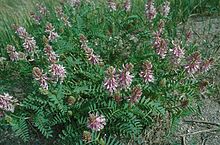| Astragalus bisulcatus | |
|---|---|

| |
|
Scientific classification
| |
| Kingdom: | Plantae |
| Clade: | Tracheophytes |
| Clade: | Angiosperms |
| Clade: | Eudicots |
| Clade: | Rosids |
| Order: | Fabales |
| Family: | Fabaceae |
| Subfamily: | Faboideae |
| Genus: | Astragalus |
| Species: | A. bisulcatus
|
| Binomial name | |
| Astragalus bisulcatus | |
Astragalus bisulcatus, commonly called two-grooved milkvetch or silver-leafed milkvetch, is a leafy perennial with pea-like flowers. It is native to central and western North America, [2] and typically grows on selenium-rich soils. It accumulates selenium within its tissues, and when livestock consume it, the selenium can be toxic. [3]
Description
Astragalus bisulcatus is a herbaceous perennial with a thick woody root-stock, growing 30 to 100 cm tall. [4] It has numerous simple stems and long pinnate leaves. The flowers are produced in narrow elongated racemes. The flowers are white or purple in color [5] and bloom in late spring and early summer. The seed pods characteristically are two grooved on the upper surface. The fruits ripen and release their seeds in July and August. [6] The seeds are dark brown or black, reniform in shape, 4 mm long and 2 mm wide. [4] [7]
Selenium toxicity
Astragalus bisulcatus accumulates large quantities of selenium when grown on soils that have selenium, the plant produces amino acids where sulfur is replaced by selenium. [8] Most animals avoid Astragalus bisulcatus because of the musky odor of the dimethyl selenium compounds contained in the plants tissues. [9] Yet, sheep and cattle have indulged in eating the plant, becoming victims of selenium toxicity. Sheep can die in thirty minutes from eating a half a pound of Astragalus bisulcatus, and in 1907 and 1908, approximately 15,000 sheep in Wyoming died with symptoms of either alkali disease or the blind staggers; both of which were outcomes of digesting a large amount of selenium from Astragalus bisulcatus. [10]
References
- ^ NatureServe (2024). "Astragalus bisulcatus". Arlington, Virginia. Retrieved 13 April 2024.
- ^ "USDA Plants Database".
- ^ "Notes on poisoning: Astragalus bisulcatus". Canadian Poisonous Plants Information System. Government of Canada. 2009-09-01. Archived from the original on 2011-06-10. Retrieved 2010-04-07.
- ^ a b New York Botanical Garden (1919). North American flora. New York Botanical Garden. pp. 281–. Retrieved 26 September 2010.
- ^ Taylor, Ronald J. (1994) [1992]. Sagebrush Country: A Wildflower Sanctuary (rev. ed.). Missoula, MT: Mountain Press Pub. Co. p. 100. ISBN 0-87842-280-3. OCLC 25708726.
- ^ United States. Division of Botany (1901). Bulletin. Govt. print. off. pp. 148–. Retrieved 26 September 2010.
- ^ "Southwest Colorado Wildflowers, Astragalus bisulcatus". www.swcoloradowildflowers.com. Retrieved 2023-02-20.
-
^
Galston, Arthur: Green Wisdom. Basic Books, Inc. 1981. p.
40.
ISBN
978-0465027125.
{{ cite book}}:|work=ignored ( help) - ^ "Cornell University Department of Animal Science: Plants Poisonous to Livestock". Selenium Poisoning. Cornell University. 2009-03-26. Archived from the original on 22 August 2010. Retrieved 2010-09-26.
-
^
Galston, Arthur: Green Wisdom. Basic Books, Inc. 1981.
ISBN
978-0465027125.
{{ cite book}}:|work=ignored ( help)
